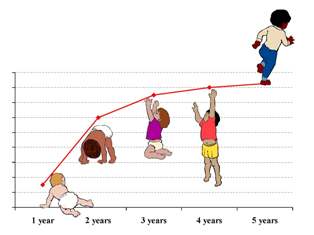Lesson 8: Infant and Toddler Guidelines, Maine Early Learning Developmental Standards

The teacher’s task is first to nourish and assist, to watch, encourage, guide, induce, rather than to interfere, prescribe, and restrict. ~ Maria Montessori
Learning Outcomes
Upon completion of this lesson's material, students will be able to:
- Discuss three aspects of the Maine Infant Toddler Guidelines that are most useful
- Explain the components and features of the Maine Infant Toddler Guidelines
- Explain the components and features of the Maine Early Learning and Development Standards
Teaching
- State of Maine Infant and Toddler Guidelines - http://www.maine.gov/earlylearning/standards/infantsandtoddlersguidelines.pdf
- Maine Early Learning Development Standards - http://www.maine.gov/doe/publicpreschool/documents/Maine-ELDS.pdf












CONSIDER THESE DOCUMENTS AS THE MOST IMPORTANT DOCUMENTS OF THE ENTIRE PROGRAM. THESE DOCUMENTS WILL FOLLOW YOU THROUGH EVERY CLASS.
- Supporting Maine’s Infants & Toddlers: Guidelines for Learning and Development - http://www.maine.gov/earlylearning/standards/infantsandtoddlersguidelines.pdf
- Maine Early Learning Development Standards - http://www.maine.gov/doe/publicpreschool/documents/Maine-ELDS.pdf
I cannot stress enough how important these Infant Toddler Guidelines, and Early Learning Development Standards are in your work with children. These two documents outline “typical” development for children up through age 8. Each documents is first organized by developmental domains and then broken down into elements/indicators.
For infants and toddlers the guidelines are broken down into four domains. That doesn’t mean that emotional development and gross motor development are not in there. They are simply embedded into the domains listed.
- Development into social beings
- Development of strong and healthy bodies
- Development of the ability to communicate
- Development of curious minds
For Maine’s Early Learning and Development Standards, there are eight domains. They are:
- Social and emotional development
- Approaches to learning
- Creative arts
- Early language and literacy
- Physical development and health
- Math
- Science
- Social studies
As already stated, each domain is broken down into elements or indicators. This will help you to identify what exactly you are targeting within the domain growth. For example:
Little Johnny is 10 months old and trying to pull himself up onto his 3.5 year old sisters leg (Sally). Johnny grabs her hard to get a good grip in order to stand and ends up accidentally pinching Sally. Sally is startled and reacts to the pain by pushing him to the ground and YELLING at him. Johnny cries and Sally runs to tell on him.
So from this observation I know that:
- Johnny is working on his gross motor skills
- Sally needs to work on social emotional skills.
I want to support them with this growth so I decide to
- look up in the Infant Toddler Guidelines, exactly which element in the gross motor domain Johnny is working on
- look up in the Maine Early Learning Development Standards, which indicator in the social and emotional developmental domain Sally is working on
For Johhny I:
- Take out the Infant Toddler Guidelines
- I find the 8-18 month age range
- I go to the domain Development into Strong Healthy Bodies
- I find that Johnny is working on the element of gross motor skills and pulling to stand is an indicator.
- I look down to find that there are also suggestions as to how I can support this growth!
For Sally I:
- Take out the Maine Early Learning Development Standards
- I go to the domain Social and Emotional Development
- I look for the 3.5 year color. It is blue so I know to look in the first column.
- I look for the indicator emotional development
- I look for an indicator that meets what she is working on. It says, “shows impulse control” and “showing concern for a peer in distress”
- I think of ways I can support her in growing this skill to promote self-regulation.
Assessment
Lesson 8 Quiz
Answer the following questions from the Infant Toddler Guidelines and Maine’s Early Learning Developmental Standards – Do NOT cut and paste. Each question is worth ten points
In your Supporting Maine’s Infants & Toddlers: Guidelines for Learning and Development
- What are the five guiding principles and IN YOUR OWN WORDS provide two sentences describing each.
- In each age section, there is a page called “applications.” Describe similarities and differences between the applications sections across the age groups.
- Provide a five sentence description for young infants.
- Provide a five sentence description for older infants.
- Provide a five sentence description for toddlers.
In your Maine Early Learning Development Standards
- What are the nine guiding principles and IN YOUR OWN WORDS provide a sentence describing each.
- IN YOUR OWN WORDS, what does school readiness mean?
- IN YOUR OWN WORDS, summarize the statement about screening, formative assessment, and curriculum.
- IN YOUR OWN WORDS, describe how the standards are organized by age and how they align with the Infant Toddler Guidelines and Maine Learning Results.
- IN YOUR OWN WORDS summarize the Maine Early Learning Development Standards statement about screening, formative assessment, and curriculum.
Bonus Question! -
- What are the Early English Language Development Standards?
Lesson 8 Discussion
The Maine Infant Toddler Guidelines is a great resource for anyone working with infants and toddlers. (Plus the photos are awesome!) Discuss three aspects of the Maine Infant Toddler Guidelines you find helpful or useful. Explain why.